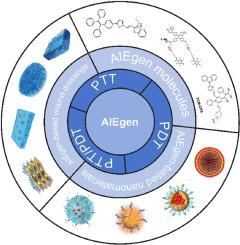Aggregation-induced emission-based phototheranostics to combat bacterial infection at wound sites: A review
IF 12.8
1区 医学
Q1 ENGINEERING, BIOMEDICAL
引用次数: 0
Abstract
The healing of chronic wounds infected by bacteria has attracted increasing global concerns. In the past decades, antibiotics have certainly brought hope to cure bacteria-infected chronic wounds. However, the misuse of antibiotics leads to the emergence of numerous multidrug-resistant bacteria, which aggravate the health threat to clinical patients. To address these increasing challenges, scientists are committed to creating novel non-antibiotic strategies to kill bacteria and promote bacteria-infected chronic wound healing. Fortunately, with the quick development of nanotechnology, the representatives of phototherapy, such as photothermal therapy (PTT) and photodynamic therapy (PDT), exhibit promising possibilities in promoting bacteria-infected wound healing. Well-known, photothermal agents and photosensitizers largely determine the effects of PTT and PDT. A common problem for these molecules is the aggregation-induced quenching effect, which highly limits their further applicability in biomedical and clinical fields. Fortunately, the occurrence of aggregation-induced emission luminogens (AIEgens) efficiently overcomes the photobleaching and exhibit advantages, such as strongly aggregated emission, superior photostability, aggregation-enhanced reactive oxygen species (ROS), and heat generation, which makes great sense to the development of PTT and PDT. This article reviews various studies conducted on novel AIEgen-based materials that can mediate potent PDT, PTT, and a combination of PDT and PTT to promote bacteria-infected chronic wound healing.

基于聚集诱导发射的光otheranostics,用于抗击伤口处的细菌感染:综述。
受细菌感染的慢性伤口的愈合越来越受到全球关注。在过去几十年中,抗生素无疑为治愈受细菌感染的慢性伤口带来了希望。然而,抗生素的滥用导致大量耐多药细菌的出现,加剧了对临床患者健康的威胁。为了应对这些日益严峻的挑战,科学家们致力于开发新型非抗生素策略,以杀死细菌并促进受细菌感染的慢性伤口愈合。幸运的是,随着纳米技术的快速发展,光疗的代表,如光热疗法(PTT)和光动力疗法(PDT),在促进细菌感染伤口愈合方面展现出了广阔的前景。众所周知,光热剂和光敏剂在很大程度上决定了 PTT 和 PDT 的效果。这些分子的一个共同问题是聚集引起的淬灭效应,这极大地限制了它们在生物医学和临床领域的进一步应用。幸运的是,聚集诱导发射光源(AIEgens)的出现有效地克服了光漂白,并表现出强聚集发射、优越的光稳定性、聚集增强的活性氧(ROS)和发热等优势,这对 PTT 和 PDT 的发展具有重大意义。本文综述了对基于 AIEgen 的新型材料进行的多项研究,这些材料可介导强效 PDT、PTT 以及 PDT 和 PTT 组合,以促进细菌感染的慢性伤口愈合。
本文章由计算机程序翻译,如有差异,请以英文原文为准。
求助全文
约1分钟内获得全文
求助全文
来源期刊

Biomaterials
工程技术-材料科学:生物材料
CiteScore
26.00
自引率
2.90%
发文量
565
审稿时长
46 days
期刊介绍:
Biomaterials is an international journal covering the science and clinical application of biomaterials. A biomaterial is now defined as a substance that has been engineered to take a form which, alone or as part of a complex system, is used to direct, by control of interactions with components of living systems, the course of any therapeutic or diagnostic procedure. It is the aim of the journal to provide a peer-reviewed forum for the publication of original papers and authoritative review and opinion papers dealing with the most important issues facing the use of biomaterials in clinical practice. The scope of the journal covers the wide range of physical, biological and chemical sciences that underpin the design of biomaterials and the clinical disciplines in which they are used. These sciences include polymer synthesis and characterization, drug and gene vector design, the biology of the host response, immunology and toxicology and self assembly at the nanoscale. Clinical applications include the therapies of medical technology and regenerative medicine in all clinical disciplines, and diagnostic systems that reply on innovative contrast and sensing agents. The journal is relevant to areas such as cancer diagnosis and therapy, implantable devices, drug delivery systems, gene vectors, bionanotechnology and tissue engineering.
 求助内容:
求助内容: 应助结果提醒方式:
应助结果提醒方式:


